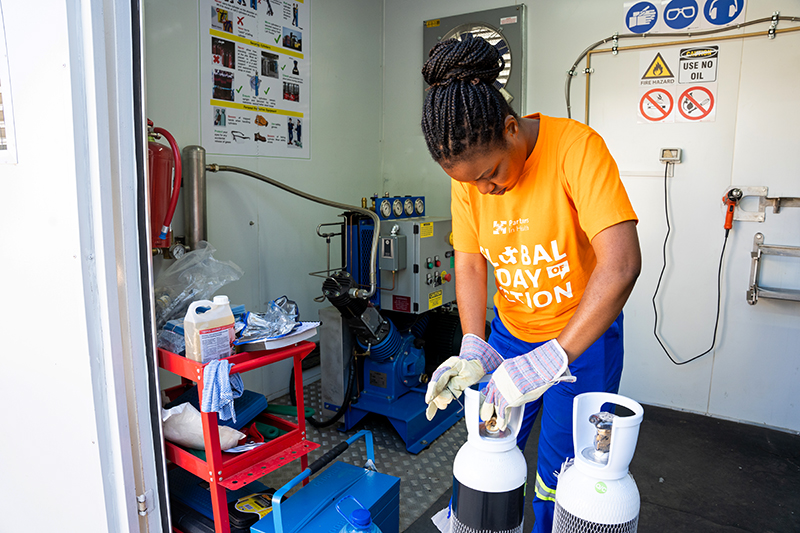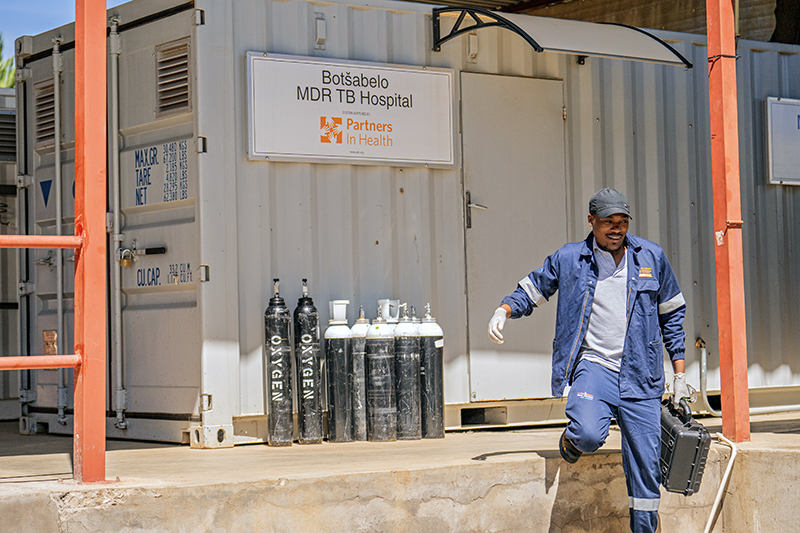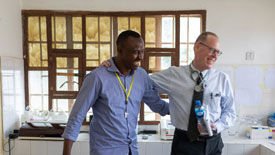Securing Supply, Saving Lives: The Training Behind Oxygen Access
PIH biomedical engineers gain skills, knowledge to keep oxygen systems running and help save lives
Posted on Mar 6, 2025

The oxygen plant in Lesotho whirs with activity, air thick with the tang of compressed gas. Francis Sambani moves through the Partners In Health (PIH)-supported facility with precision, reading pressure gauges on the oxygen manifold while the rhythmic chug of compressors punctuates the quiet.
The machinery Sambani attends is vital. Just a two-minute walk away at Botšabelo Hospital, patients battling tuberculosis and pneumonia depend on the medical oxygen it generates for their treatment and recovery.
Until recently, PIH bioengineers like Sambani needed to rely on external contractors—often from a manufacturer based in South Africa—to diagnose and repair any mechanical issues that occurred at plants. It was a dependency that sometimes led to costly delays, directly impacting patient care.
But a shift is underway: a training for PIH’s in-house biomedical engineers, developed and led by Build Health International (BHI) in collaboration with PIH, is equipping staff with the skills to maintain and repair machinery independently. Last November, a five-day intensive course at Koidu Government Hospital (KGH) in Sierra Leone marked a major step, immersing ten PIH trainees in specialized plant operations and maintenance.
Hands-On Learning in Sierra Leone
PIH-supported hospitals, including the one where Sambani works, often serve as depots, creating oxygen through pressure swing adsorption (PSA). During this process, air is drawn in from the atmosphere, filtered, and separated to extract 90%+ pure oxygen before it is distributed in portable cylinders to facilities nationwide. With 60% of the world lacking access to safe, affordable medical oxygen, this steady supply and distribution is crucial for patient care.
Sambani reflects on how, before the recent PSA training, even minor fixes, such as replacing a compressor belt, required outside intervention. “We would see them come and see what they did,” he said of the external contractors, leading him to think, “Okay, maybe we just haven’t been trained on this. It’s not that hard. It’s not rocket science. And even if it is rocket science, it’s made by a man—still you can learn it.”
That mindset took hold. The Cencora Foundation-sponsored training brought together plant leads from Lesotho, Liberia, Rwanda, Malawi, and Sierra Leone. Unlike typical seminars, however, this training—designed by BHI’s global medical oxygen team with input from PIH—took place inside a working PSA plant, where spare equipment was repurposed for practical learning.
“A lot of times, people get a conference room in a hotel with flipcharts and training slides,” said William Haggerty, senior technical lead at PIH, who co-designed the course. “We need to move away from that model and be very hands on. We want people working with the equipment, spending time in the PSA plant, turning wrenches.”
Participants tackled real-world scenarios over a week, troubleshooting oxygen supply issues that frequently arise across PIH-supported sites. “We took everything apart and put it back together,” Sambani said. “We were able to create problems and learn about other parts and what they do—maybe the air compressor, maybe the oxygen compressor. It was really fun just being in that classroom and learning.”
The training was equally transformative for biomedical engineer Grace Bwanali from Malawi. “Before, whenever there was a problem with the plant, we were not able to do proper troubleshooting due to a knowledge gap,” she said, “leading to very long PSA plant downtime. But now, we can do that on our own—identify the problem and resolve it.”

The training occurred just minutes from the Maternal Center of Excellence, a state-of-the-art facility under construction at KGH. Trainees toured the site, and Sambani was struck by the foresight that went into its design. “It’s beautiful inside. Everything is so thought through,” he said. “The technology, the standard—everything. They even made sure that the walls look nice.
“Whoever was involved in that process wasn’t just thinking about today. They were thinking 10 years down the line: What will still work? How much capacity do we need? Let’s not just do something for now. I would really love to work there. It’s so inspiring. This is what we should be doing.”
Strengthening Oxygen Systems for the Future
Beyond mechanical repairs, PIH biomedical engineers must also ensure the stability of overall hospital infrastructure. This involves collaborating with worldwide procurement and logistics colleagues to ensure spare parts arrive on time, make it through customs, and are properly stored, as well as upskilling in related specialties such as electrical systems.
“I’m not an electrician by profession, but I know a little because my work sits in the middle of different fields,” Sambani said, describing his need to pivot between various elements of oxygen plant machinery. “I have to know a bit of this, a bit of that. Even the sound of a compressor tells you when something is off. You learn to listen.”

A colossal amount is at stake when it comes to well-functioning oxygen infrastructure, as Bwanali put plainly: “With undisturbed production, we ensure that oxygen is administered to all patients, reducing deaths.”
With such training, biomedical engineers like Sambani and Bwanali are better equipped to ensure lifesaving oxygen reaches patients who need it most. And they aren’t working in isolation—graduates of the Sierra Leone training program stay tightly connected through a WhatsApp group, exchanging knowledge and advice in real-time from their facilities across Africa.
Highly trained engineers mean more reliable oxygen supplies, fewer disruptions in care, and ultimately, more lives saved. Sambani will continue to work with precision amid his plant’s machinery in Lesotho, keeping it running 24 hours a day—and with the expertise and dedication of people like him and Bwanali, the oxygen will keep flowing.

